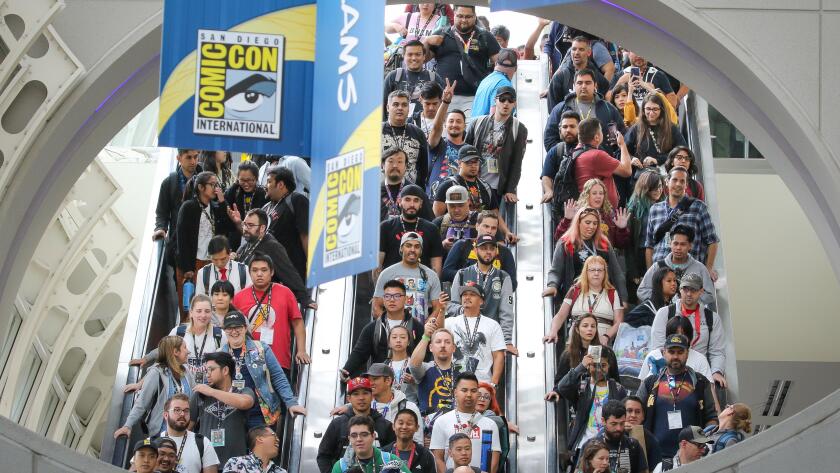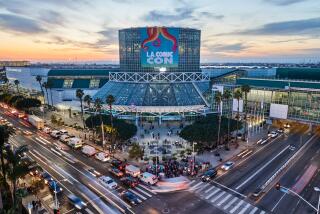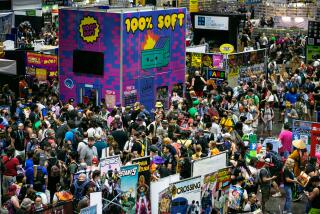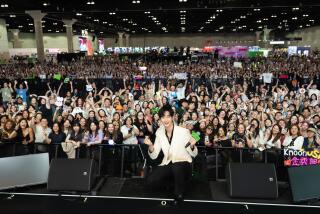Comic-Con is San Diego’s hottest ticket. How the city is mourning its loss
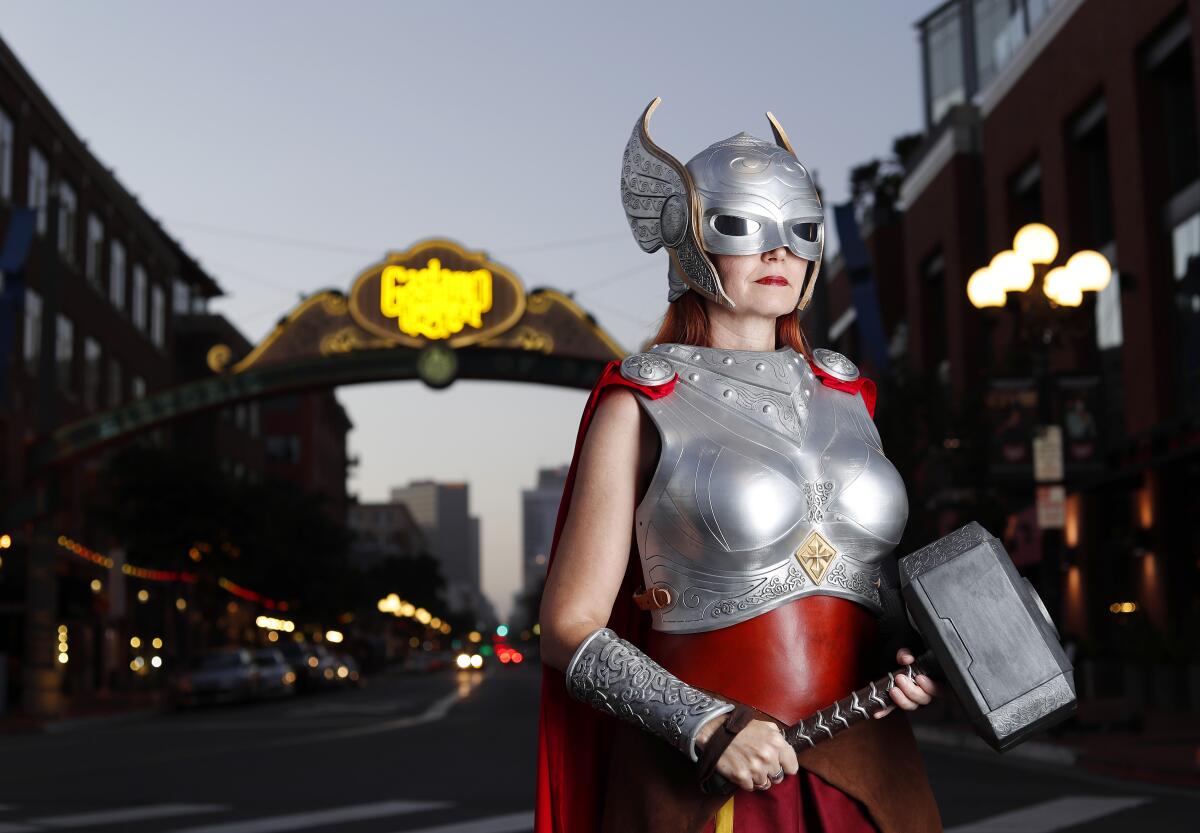
SAN DIEGO — Deadpool wasn’t going to miss it for the world or the pandemic.
On Wednesday afternoon, the preview day of what would have been the 51st edition of San Diego Comic-Con, the bars surrounding the downtown convention center were empty, the restaurants mostly deserted, and the sidewalks devoid of the usual throngs of people dressed as their favorite characters.
It was a lonely landscape, except for one figure in head-to-toe red.
A man dressed as Deadpool, the wisecracking Marvel antihero, stood before the waterfront convention facility in a full bodysuit and red-and-black mask. He posed for a few photos with no audience but his niece Sarah Ladeby, 21, and declined to give his name, staying strictly in character. (“It is funny that he’s here to do this, though,” Ladeby chuckled.)
Our Deadpool said he’s been coming to San Diego Comic-Con for 27 years. There’s no actual convention to attend this week, however, as the COVID-19 pandemic forced the first-ever cancellation of the in-person gathering. “I can at least say that I came to Comic-Con 2020,” the cosplayer said.
And in a sign of how seriously he meant it, the figure flashed his nonofficial 2020 Comic-Con “badge,” which he made himself. He decorated it with an image from “The Walking Dead” and the term “Covid Edition.” His badge name: Ryan Reynolds, the lead actor in the “Deadpool” films. Instead of Press or Attendee, it read Survivor.
“It is weird, and it is sad,” said our hero, who added that he is a “nerdy engineer” from Mexico by day. “And it’s not only us, it’s all of those restaurants, all of those hotels. Let’s call it fair, in the sense that it affects everybody.”
Every year since 1970 (the now-legendary founders first gathered to geek out on comics in 1969), hardcore fans of everything comics, sci-fi and fantasy have gathered in San Diego for Comic-Con. It seems every longtime San Diegan has a fond or funny memory associated with the convention; this town is not as used to celebrity sightings as Los Angeles.
Not having Comic-Con this year feels for many like a glitch in the matrix.
“It’s nuts. I still can’t hardly even believe it, like, ‘Is this really happening?’,” said Dean LeCrone, a cartoonist and cosplayer from Oceanside who dresses as an original steampunk character named Dr. Artemus Peepers, who time-travels with a half-dragon, half-rabbit figure named Driggon the Drabbit. “I’m really missing it.”
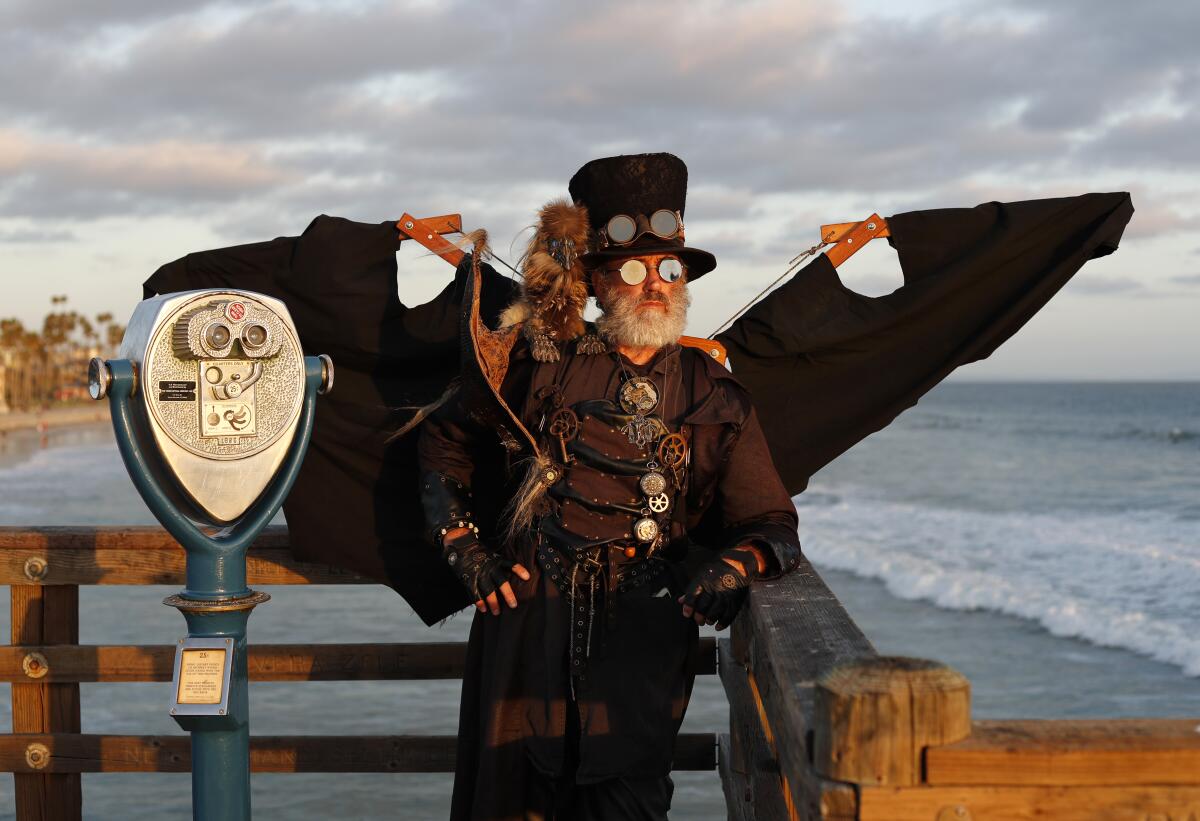
The dissonance is particularly felt given how much Comic-Con has transformed over the last decade or so, as it ballooned into a media mega-machine that drew international attention to film and television’s most lucrative franchises and Hollywood’s biggest stars, and arguably threatened its classic San Diego vibe, laidback and welcoming.
But this year, as human civilization has actually started feeling a bit like a dystopian comic-book series of its own, Comic-Con going virtual is reverberating through the streets — and local commerce.
The in-person convention was expected to pump $97.9 million of direct spending into the San Diego economy, which would in turn create an estimated regional economic impact of $166.2 million, said Maren Dougherty, communications director for the San Diego Convention Center. That makes San Diego Comic-Con one of the most significant single economic boons for the entire region, one that’s now lost.
Most years, Comic-Con draws thousands more people than are able to get inside, producing a carnival-like atmosphere on the Gaslamp Quarter’s streets. Cosplayers greet tourists. Even the hot dog carts come out.
“There is this tradition of people just going downtown to hang out, and then you have all this activity happening in places you don’t usually think about, like gas stations, dry cleaners, grocery stores,” in addition to hotels, bars and restaurants, Dougherty said.
The Gaslamp district, consisting of 16 blocks of picturesque Victorian buildings that house some 400 businesses ranging from restaurants to boutiques, was a landscape of relative emptiness this week; few if any people were out and about on most blocks.
“You get visitors coming and staying in the hotels, eating in the restaurants, booking out large parties, and now you don’t have that, along with every other convention that has canceled,” said Michael Trimble, executive director of the Gaslamp Quarter Assn. “It’s a bummer that it’s not happening but understandably ... There are times when you are elbow-to-elbow just trying to make your way through.”

Fans and artists with nowhere to go physically for the event are instead being asked to tune in to a four-day slate of panels and presentations online. Comic-Con@Home, as it’s called, covers topics ranging from comics in schools to an academic discussion of the “cruelty of masks” in HBO’s “Watchmen.”
In a welcome message, state Sen. Toni Atkins applauded organizers for successfully keeping the spirit of Comic-Con alive online.
“From its humble beginnings in the heart of downtown San Diego at the El Cortez Hotel, to becoming the largest pop culture convention on Earth [...] you’ve all helped put Comic-Con and San Diego on the map, making it cool to be a self-proclaimed geek,” Atkins told organizers.
Despite the high spirits virtually, local fans this week were not taking it well.
“It’s the biggest event of the year, really, isn’t it? It’s more than just a geek fest. It’s huge for the city,” said Anthea Rodgers of Coronado, who was browsing inside Now or Never Comics in downtown San Diego with her three children. “Today what we’d normally do is take the ferry over, I’d register the kids, then we’d do a quick walk-through, because it’s preview night.
“Then we’d come back the following day with a schedule of what we’d want to do,” she said. “And we’d do four days of that.”
An estimated 135,000 were expected to attend, many clamoring to get a coveted entry to Hall H, the convention center’s hottest ticket during Comic-Con because it is traditionally the room where the biggest headliners show up. It’s also a menacingly packed environment in terms of the potential for viral spread. Because of the pandemic, Hall H has been in use since April as a temporary homeless shelter, taking in an about 1,200 unhoused people.
“It would be a total COVID crazy center because everyone’s so close,” Ladeby, the Deadpool cosplayer’s niece, said of the convention.
For longtime attendees, the absence this year is yawning, and a sad reminder of how deeply ingrained the convention is in local identity. “This would have been my 30th year,” said LeCrone, or Dr. Artemus Peepers, wistfully. “Back in 1990, you could still walk up to the convention center, and just get in line, and wait and get a ticket.”
Across from the convention center, on a small plaza near a trolley station and the Tin Fish seafood restaurant, fans set up an altar for the missing in-person convention, replete with flowers, memorabilia, and messages of hope and resilience.
“Someone just came up and asked if they could do it,” said restaurant manager Jim Gorzelanksi, who was feeling the pain himself. “I would have 40 people working today instead of four.”
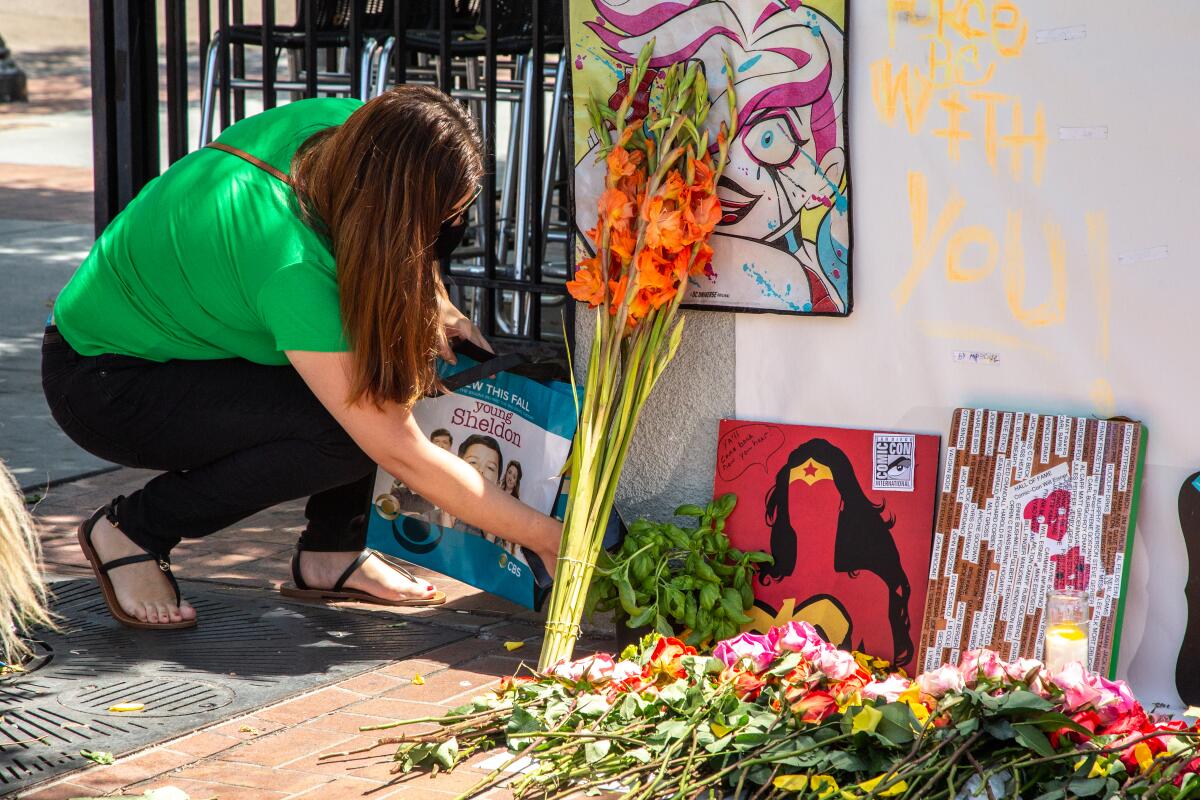
But business was slightly up at F Street’s Now or Never Comics, which opened in 2018 and is the only store dedicated to comics in the vicinity of the convention center. Founder Aaron Trites said he was “busy” from a pandemic perspective, letting in about five people at a time. It was the customary preview day for Comic-Con, and also “new comics day,” meaning the delivery of new editions of comics series to stores. (Remember those?)
He said the altar a few blocks away crystallized the importance of Comic-Con to everyday San Diegans.
“That speaks to the city’s devotion to the con. There’s not going to be a geologists convention that pulls out of the convention center — nobody’s going to set a memorial for that,” Trites said, as comic aficionados browsed around him in masks.
“All day people have been coming in saying it doesn’t seem like summer” without Comic-Con, he said. “Even for the Padres. I don’t think there’s a Padres memorial for the season. ... The ‘Game of Thrones’ cast would show up at a random pizza place, or you’d be waiting behind Robert Downey Jr. at a Starbucks. I’ve never seen that anywhere.”
More to Read
The biggest entertainment stories
Get our big stories about Hollywood, film, television, music, arts, culture and more right in your inbox as soon as they publish.
You may occasionally receive promotional content from the Los Angeles Times.

